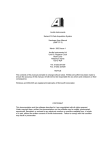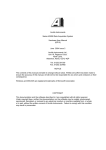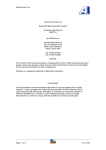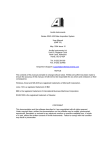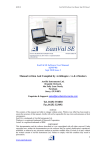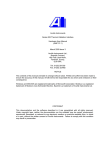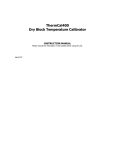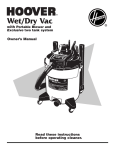Download Series 615 hardware handbook
Transcript
Anville Instruments Ltd Series 615WD Data Acquisition System Hardware User Manual (QMF 37) Feb 2004 Issue 2 Anville Instruments Ltd Unit 19, Pegasus Court North Lane, Aldershot Hants, GU12 4QP Tel. 01252 351030 Fax. 01252 323492 NOTICE The contents of this manual are liable to change without notice. Whilst every effort has been made to ensure the accuracy of this manual, Anville Instruments Ltd will not be responsible for any errors and omissions or their consequence. Windows is a registered trademark of Microsoft Corporation. COPYRIGHT This documentation and the software described in it are copyrighted with all rights reserved. Under copyright laws, neither the documentation nor the software may be copied, photocopied, reproduced, translated, or reduced to any electronic medium or machine readable form, in whole or in part, without the written consent of Anville Instruments Ltd. Failure to comply with this condition may result in prosecution. S615WD Hardware User Manual. Feb. 2003. Iss.2 CONTENTS QMF 37 PART I: INTRODUCTION TO THE SERIES 615WD PART II: SERIES 615WD CONFIGURATION PART III: CONNECTING THE SERIES 615WD TO YOUR COMPUTER PART IV: SPECIFICATIONS Page 2 of 18 S615WD Hardware User Manual. Feb. 2003. Iss.2 AN OVERVIEW OF THIS USER MANUAL This manual is divided into 4 parts. Part I introduces you to the SERIES 615WD. Starting with Part II, the manual shows you how to configure and operate the unit. After mastering the system, you can use the manual as a handy reference. When you need help with a specific problem, turn to the appropriate area of the manual that describes that part of the system. To give you an idea of the manual’s layout, here is a description of each part of the manual: • Part I describes the hardware for both the SERIES 615WD and the computer system. • Part II describes system hardware configuration and tells you how to connect the different types of sensors. • Part III tells you how to connect the SERIES 615WD unit to your computer. • Part IV provides specifications for the SERIES 615WD equipment. QMF 37 Page 3 of 18 S615WD Hardware User Manual. Feb. 2003. Iss.2 PART I: INTRODUCTION TO SERIES 615WD OVERVIEW Welcome to the SERIES 615WD Washer Disinfector Data Acquisition Unit. The unit runs with Prodigy SCADA computer based software package to monitor and record the operation of washer-disinfector systems. The SERIES 615WD is connected to a compatible computer system which provides the SCADA software operating environment working under Win’95/98,Windows NT, 2000 and XP. The compact hardware provides 8 general purpose analogue inputs, 8 digital inputs and 2 digital outputs. Connection to a computer, using a suitable cable type, is made via an RS232422/ serial link. Please refer to Part IV for cable specifications. An additional RS232/422 connector J2 allows you to ‘daisy-chain’ SERIES 615WDs together if more analogue inputs are needed. The SERIES 615WD’s internal microprocessor converts all inputs into their correct engineering units for transmission to the host computer. COMPATIBLE COMPUTER SYSTEM Your computer system should comprise a system unit, SVGA monitor, keyboard and printer. The minimum requirement for the system unit is a Pentium processor, a 5 Giga byte hard drive, 128Mbytes of RAM, CD disk drive and floppy disk drive. It should also have at least 1 serial port for connection to the logger and a parallel port for a printer. Computer The system unit is the large box component of the computer. The back of the unit supports all ports used for connecting your peripheral equipment including the SERIES 615WD. Your SERIES 615WD will plug into to either COM1 or COM2 serial port using the assembled data cable but on some system units the mouse could be using COM1, which means using COM2 instead. It is also possible that COM2 is a 25-pin connector. In this case you’ll need a 25-pin (female) to 9-pin (male) adapter. A printer port is also required. The system unit houses the PC's main microchip and the computer's internal memory as well. The memory has several names. You commonly hear it referred to as RAM (Random Access Memory). The SVGA Monitor The television-like screen is called the monitor. The monitor is one place where graphical data and spreadsheet data will be sent for viewing. Your monitor plugs into the back of your system unit. The Printer Your printer provides a more permanent way of recording your SERIES 615WD's system results. It can be used to provide hard copies of on-screen information and spreadsheet data. The printer can be described as the `typewriter' of a SCADA logging system. The printer plugs into the parallel port at the back of the system unit. The Keyboard The keyboard plugs into the back of your system unit. Most of the keys are the same as a standard typewriter. The letters and numbers in the large centre of the keyboard produce the characters that you type on-screen. In the main you will use only these keys in conjunction with using your mouse. QMF 37 Page 4 of 18 S615WD Hardware User Manual. Feb. 2003. Iss.2 PART II: SERIES 615WD CONFIGURATION DC voltage Unit Configuration switch array Digital input connector Frequency input RS232/422 selector Serial Out connector Serial In connector Digital output connector 230VAC input connector Input connectors Figure 1 Series 615 layout Box Address Your SERIES 615WD is supplied with its’ address set to zero. An address is set by the positions of switches 1 to 4 of the UNIT CONFIGURATION switch array. See Figure 1. If more than one SERIES 615WD is to be used on the computer port, it will be necessary to alter switch settings of any additional SERIES 615WDs thus providing each one with a unique address. For example, box 1 will have address 0, box 2 address 1 and so on. To initialise switch settings, power to the SERIES 615WD must be turned off then on. The table below provides configuration address and switch settings. Switch setting 1 2 3 4 on on on on off on on on on off on on off off on on on on off on off on off on on off off on off off off on on on on off off on on off on off on off off off on off on on off off off on off off on off off off off off off off QMF 37 Unit address 0 1 2 3 4 5 6 7 8 9 10 11 12 13 14 15 Page 5 of 18 S615WD Hardware User Manual. Feb. 2003. Iss.2 Communication Baud Rate Your SERIES 615WD is supplied with baud rate set to 9600. If you need to change the baud rate, use switches 5 and 6 of the UNIT CONFIGURATION switch array. The following table gives switch settings for specific baud rates. To initialise switch settings, power to the SERIES 615WD must be turned off then on. Please note that whichever baud you configure, you must also set the same baud rate in Windows Control Panel to match. See below how to do this. Switch settings 5 6 on on off on on off off off Baud rate 1200 2400 9600 19200 Communication Format The communication format is fixed and will consist of 8 data bits, 1 stop bit, no parity, flow control- none. Please note that if you are not using the SERIES 615WD’s software it is very important that you set the communication format and baud rate for the chosen serial port using WINDOWS Start, Settings, Control Panel before operating the SERIES 615WD. Frequency Input The Series 615WD provides inputs for measuring both pulse count and frequency (Hz). The type of input configuration is dependent on the type of signal output from equipment connected to the logger. Selection of counter or frequency is made during software configuration. Connections to the logger are made via a 4-way screw block plug. The table and diagrams below show pin and input connections. Pin No. 1 3 Signal Name +5V output trig. level Pin No. 2 4 Signal Name input ground A logic level/uni-polar input with a signal level of between 0V to 5V (CMOS/TTL) would (generally) use the connections shown in the Logic Level Input Circuit diagram. 0V to 2.4V ±100mV = logic 0; 2.6 ±100mV to 5V = logic 1. Pulse count input has a range of 0 to 65535 counts. Counts are not cumulative; each ‘new’ count will replace the previous count. Logic Level Input Circuit An AC signal/bi-polar input, from 0 to 65Khz, would (generally) be measured using the Zero Crossing Level circuit connections with voltage levels from 100mV peak-to-peak to 10V peak-to-peak. Voltage levels below 100mV will not be ‘seen’ by the logger. QMF 37 Page 6 of 18 S615WD Hardware User Manual. Feb. 2003. Iss.2 Zero Crossing Level Circuit The +5VDC on pin 1 can be used to power devices where the current requirement is not more than 5mA. Digital Inputs (dig-in) The SERIES 615WD provides 8 optically isolated digital inputs. With reference to the table below, dig-in signals on pins 2-5 are measured with respect to pin 1 and dig-in signals on pins 5-8 are measured with respect to pin 6. Pin 1 2 3 4 5 Signal name ground dig-in 1 dig-in 1 dig-in 1 dig-in 1 Pin 6 7 8 9 10 Signal name ground dig-in 1 dig-in 1 dig-in 1 dig-in 1 The input connector provides access to one end of the LED of an optical isolator with a 4K7 series resistor to limit current. Connections are via a 10-pin plug supplied with the unit. A typical digital input circuit Digital Outputs (Dig-out) The SERIES 615WD provides 2 digital outputs. These are open collector transistor type outputs capable of directly driving relays. With reference to the table below, Dig-out 1 and Dig-out 2 drive a comprises a 2pole relay having a Normally Closed and a Normally Open contact. Connections are via a 6 pin plug supplied with the unit. Pin no. 1 2 3 QMF 37 Dig-out 1 ground N/C N/O Pin no. 4 5 6 Page 7 of 18 Dig-out 2 ground N/C N/O S615WD Hardware User Manual. Feb. 2003. Iss.2 A typical digital output circuit QMF 37 Page 8 of 18 S615WD Hardware User Manual. Feb. 2003. Iss.2 PART III: CONNECTING THE SERIES 615WD TO YOUR COMPUTER IMPORTANT NOTE: please refer to PART IV: SPECIFICATIONS for preferred cable type. Caution: The following cable assembly instructions will probably require the use of a soldering iron. Some familiarity with soldering techniques would be useful. RS232 Transmission To connect the data logger to your PC it is necessary to assemble a serial data cable. Connection details are given in the table. One end of the cable will have 3 flying leads to connect to J1 and the other end terminated with a 9-pin D type socket. The length of the cable is determined by how far the Series 615 is from your computer but should not be more than 20 metres. The system requires transmit (Tx), receive (Rx) and ground connections for most applications, so these are the only signal connections made. J1-Terminal 1 2 3 4 5 6 Signal name Not used Tx Rx Wire screen white black ‘D’ skt ground ground screen - 5 2 3 The SERIES 615WD has two serial port connectors, SERIAL IN and SERIAL OUT. As a general rule, SERIAL OUT will be connected to your computer in a single unit installation. Where a second unit is used, it will be connected into the system by ‘daisy chaining’ the SERIAL IN of the first unit to the SERIAL OUT of the second unit. serial connector pin configuration Cable connections for ‘daisy chaining’ a SERIES 615WD are given in the table below. J2-Terminal 1 2 3 4 5 6 Signal Name Tx Rx ground ground Signal direction from 615WD to 615WD - Wire white black screen screen RS422 Transmission If the overall line length (distance) between your PC and the second daisy-chained logger exceeds 20 metres (approx. 65 feet) an RS422 serial card must be fitted to your PC to maintain signal integrity. Connection details are given in the table. One end of the cable will have 5 flying leads to connect to J1 and the other end terminated with a 9-pin D type socket. The system requires transmit (Tx-,Tx+), receive (Rx,Rx+) and ground connections for most applications, so these signal connections should be made. QMF 37 Page 9 of 18 S615WD Hardware User Manual. Feb. 2003. Iss.2 J1-Terminal Signal name Wire 1 2 3 4 5 6 Rx+ RxTxTx+ Ground Ground black red black white screen screen Serial Solution ‘D’ type 7 6 1 2 5 - Moxa ‘D’ type 3 4 1 2 5 - RS232/RS422 Selection Set switches to suit operation. Power Up Caution: in order to comply with European EMC legislation the Series 615WD must be connected to mains earth. All input voltage connections must be carried out by a qualified person. Before the unit can be used, 230VAC must be connected. Using a standard 3 core mains cable terminated at one end with a suitable plug, connect the other end to the 230VAC connector mounted on the base plate. Punch out a hole to suit in the side of the box, fit a gland (supplied with the unit) and run in the cable. Make connections with reference with Figures 1 and 2. The fitted fuse is 1Amp slow-blow. Figure 2 Mains I/P connections The SERIES 615WD is dc powered requiring +5V at 1.2A and ±12V at 0.12A. These voltages are provided by a 230V AC input power supply. DC power enters the SERIES 615WD via a 4 pin polarised connector that is mounted on the 615’s Digital printed circuit board. Connection details are: Pin 1 2 3 4 Wire Green/Yellow Black Red Violet Signal name Earth 0V +5V +24V Sensor Connection Details All connections are made through convenient solderless screw 8-way terminal blocks supplied with the SERIES 615WD. All connectors have +24VDC available between pins 7 and 8 for sensors, such as transducers that require a DC voltage input to function. Sockets are polarised for ‘one-way’ plug connection. QMF 37 Page 10 of 18 S615WD Hardware User Manual. Feb. 2003. Iss.2 Figure 1:connector socket pin orientation Figure 2: voltage pin-outs Analogue Inputs Figure 3: Voltage input Figure 4: Current loop input: 4 to 20mA (powered by transmitter or other external source) Figure 5: Current loop input: 4 to 20mA (powered by Series 615WDSB) QMF 37 Page 11 of 18 S615WD Hardware User Manual. Feb. 2003. Iss.2 Figure 6: Thermocouple input Note: do not fit link between pins 4 and 5 if using grounded thermocouples Figure 7. Pt100 or resistive inputs Figure 7: Strain/load type transducer input QMF 37 Page 12 of 18 S615WD Hardware User Manual. Feb. 2003. Iss.2 Transducer Connections 4-20mA output. Please note that this wiring diagram is an alternative to Figure 4 and should be used if a transducer, connected as Figure 4 does not respond. The example shows how you would connect a 2-wire transducer to the unit using the +24V DC source. Voltage output. Please note that this wiring diagram uses Figure 3 connections. The example shows how you would connect a 2-wire transducer to the unit using the +24V DC source. QMF 37 Page 13 of 18 S615WD Hardware User Manual. Feb. 2003. Iss.2 PART IV: SPECIFICATIONS DATA LOGGER Construction The SERIES 615WD data logger is housed in a polycarbonate box with a removable clear plastic lid having an IP65 rating. The lid is secured in place with 4 retaining screws. Printed circuit boards (PCB) and power supply that make up the Series 615 are mounted on metal base-plate secured to the bottom of the box. All components are mounted on the PCBs with the exception of a DC power supply and mains voltage input connector which are secured to the base plate. All sides of the box have punch-out holes to run cables in and out. Punched out holes must be fitted with suitable glands that form part of the boxes kit. Dimensions: 29.7cm long, 35.1cm wide (including brackets), 13.5cm deep (including lid and brackets). Connectors • • • • • • • • 8 inputs (general purpose connectors). 2 RS232/488 ports 1 digital input 1 digital output 1 analogue output (option) 1 power input 1 frequency input 1 AC input. Switches • 4 unit configuration • 2 baud rate Mounting and Ventilation To wall mount a logger use the brackets fitted to the bottom of the box. Bracket lengths extend beyond the size of the box sufficient to allow screws to be fitted. The box can then be fixed to the wall using the brackets. The logger requires no special ventilation requirements. Cleaning Loggers are easy to clean. Use a non-abrasive or foam cleaner. ANALOGUE INPUTS Direct Voltage and Current Range ±10mV ±100 mV ± 1V ± 10v 4-20mA QMF 37 Resolution 1uV 10 uV 100 uV 1 mV 0.01% Page 14 of 18 Accuracy ±0.02% ±0.02% ±0.02% ±0.02% ±0.02% S615WD Hardware User Manual. Feb. 2003. Iss.2 Thermocouples Input range °C -200 to +400 -100 to +200 -200 to +1200 -100 to +200 -100 to +1100 0 to +1300 -100 to +1000 0 to +1700 0 to +1700 0 to +1800 Input function T thermocouple T thermocouple K thermocouple K thermocouple J thermocouple N thermocouple E thermocouple R thermocouple S thermocouple B thermocouple Resolution °C 0.1 0.01 0.1 0.01 0.1 0.1 0.1 1 1 1 Accuracy °C* ± 0.5 ± 0.25 ± 0.5 ± 0.5 ± 0.5 ± 0.5 ± 0.5 ±4 ±4 ±4 * Note: accuracy includes cold junction error when using thermocouple sockets but not when using general purpose sockets. PT100 - 100 ohms @ 0°C, 4 wire connection Range °C -100 to +600 -100 to +200 Resolution °C 0.1 0.01 Accuracy °C +/-0.5 +/-0.2 Pressure transducer/load cell Range ±10 mV ±100 mV ±1V ±10 V Resolution 1 uV 10 uV 100 uV 1 mV Accuracy ±0.02% ±0.02% ±0.02% ±0.02% Signal conditioning For thermocouple, PT100 and pressure transducers. Transducer energisation • For PT100: switched constant current of 1mA. • For pressure transducer/load cell: switched constant voltage of 10V. • For 4-20mA current loop: switched constant voltage of 24V. Input switching Reed relay - 3 pole switching. Engineering units As appropriate or selectable: mV, V, mA, C, % ( as appropriate or selected). Scan speed 8 inputs per second Configuration using software. QMF 37 Page 15 of 18















